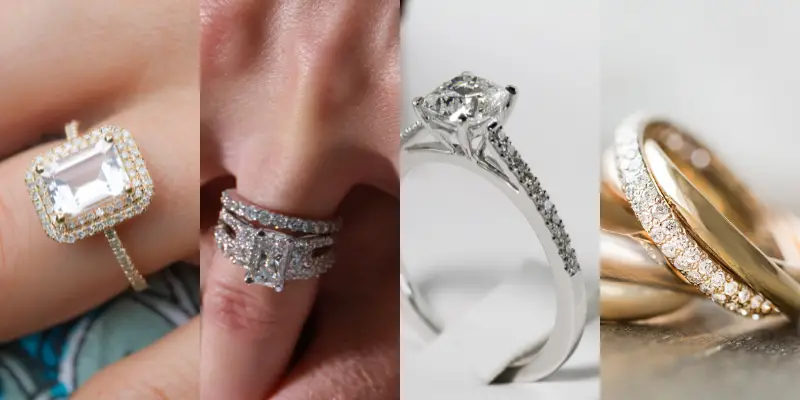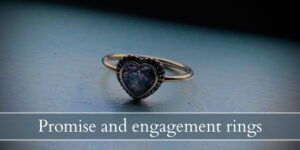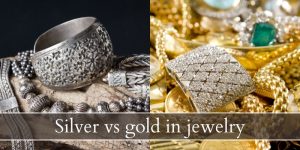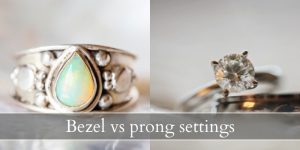Wondering if you should keep your ring plain or bedazzle it with diamonds ? Pave bands are the most impressive bands out there, and they can instantly upgrade any solitaire into something decadent and glamorous. So let’s talk about the ley things to know when looking for a pave band, and tips on choosing one.
What is a pave band ?
Pave bands are rings that are studded with tiny diamonds, and the overall effect is a uniform sparkle, as if the ring was made entirely out of diamonds and not metal. The aim of a pave band is to add extra flair and sparkle to a ring, or any piece of jewelry.
The name pave comes from the French word ‘pave’, which means paved, cobbled (as in cobble stones). This is a reference to the way the diamonds look when set into the band, like tiny, sparkling pavement pieces. Pave is a very broad term encompassing many methods of setting tiny diamonds into the ring shank, but the overall effect is the same.
Pave, micropave, French pave ?
There are several pave methods, but they all result in a row or series of rows of tiny diamonds sparkling on the ring. The classic is the pave, usually a single row of small (as in 0.1 carats or less) diamonds, usually matching the diameter of the band. Most of the time pave diamonds are set with tiny, tiny prongs but the shank can be prepared differently.
Some jewelers prefer to meticulously build a set of tiny prongs all around the ring, then place a diamond in each spot, and then close all 4 prongs over each and every diamond. Others prefer to drill a small groove into the ring for each diamond, set the diamond in the groove, then push bits of metal onto the corners, holding the diamonds together.

Those are the two main ways of building a pave band and the ones with individual seats for the diamonds (could be V or U shaped) allow more light into the diamond by revealing the sides, but take up much more time. The grooves are a bit simpler but they have a higher chance of losing a diamond or two.
Micropave rings are simply made with the tiniest diamonds, smaller than the regular pave. Micropave diamonds use 0.01 carat diamonds, most of the time using the groove and bead method. Imagine building a diamond seat for every tiny diamond!
French pave diamonds are a mixed bag. They can be any sort of pave, since the name doesn’t mean anything different, and can be applied to any pave style (minus the micropave which is distinctive in its own way).
Are channel settings actually pave ?
You might be wondering if channel set diamonds are actually pave. There is a difference, and that is the way the diamonds are held. Pave diamonds are only pave if each diamond is held onto by a prong or bead. In channel settings the diamonds are all set in a row into a long groove (channel) and are all held in place by a long, thin band running along the bottom and top of the diamond. So nothing else holding them in place, not a bead or a prong.
You might see some pave settings with the added protection very similar to a channel setting. But if you look closely the diamonds are actually held in place by beads, the raised band is only there to further protect the diamonds.
Do pave bands sparkle ?
Yes, pave bands do sparkle but since the diamonds are so small their flashes of light will also be very small. In most lighting pave bands will simply appear white, and will only throw a bit of color in direct sunlight or spotlighting.
Perhaps the best combination for a pave band is a solitaire ring. In most solitaire settings the center stone will be far larger than the tiny pave diamonds, which won’t detract from the beauty of the center. Instead the pave will act like a series of very small and dainty accent stones, without competing for your attention.
Pave bands do work with halos, but the ring can become too much when the center is big, the halo is big, and there is a pave band going on at the same time.
Are pave bands comfortable ?
Pave bands aren’t as comfortable as a plain metal band, since there are dozens of tiny prongs or beads holding the diamonds onto the ring. In time those can cause a bit of chafing, but most people get used to them. This is directly related to the size of the diamonds. Larger diamonds mean a thicker band and larger prongs or beads. A full pave band is basically an eternity ring with a center diamond.
One way to ensure your pave band is more comfortable is to not get a full pave. Instead get one where the diamonds only go down the shoulders of the ring, and stop just before your fingers meet. That leaves the rest of the ring diamond-free, so there won’t be diamonds rubbing against your other fingers or on the underside of the ring.
Do pave bands snag on clothes or hair ?
Pave bands can snag on clothes and hair, yes. This is because they have very, very small prongs or beads and the very thin threads of some clothes can get caught up in them. In some cases running your hand through your hair can snag a single hair or two, which is never pleasant. These things happen most often with full pave bands, or eternity rings.
Are pave bands tacky ?
Pave bands can be tacky if there is already too much going on in the ring. A large center stone, like a 3 carat cushion, with a double halo and a micropave setting will look a bit tacky since there are so many diamonds competing for your attention. Your eye is drawn to everything at once.
In these cases it’s best to leave one thing understated, or completely omit it. For example a large center stone but set as a solitaire (not halo) and with a nice pave band. Or a large center with a single halo and plain metal band. Or a cluster center with no halo and the daintiest micropave in a single row, perhaps with a milgrain detail.
What to know before buying a pave band
Is your heart set on a pave ring ? There are some things you definitely need to know before purchasing on of these, since they have a few limitations and also some perks. Here’s what you need to know.
You cannot resize a full pave ring
Resizing will happen for most people eventually. You lose weight, gain weight, doesn’t matter, the ring doesn’t fit anymore. Well, if it’s a full pave you can’t resize it. To resize it you can’t just take out a diamond or two and widen or tighten the ring. That would loosen the other diamonds or completely knock them out of their setting.
No, if you need a full pave resized you have just a few options. First is to get a whole new ring in the new size. Depending on your budget it may or may not be a good idea. Second, you ca get sizing beads added to the inside of the ring if the ring is now loose. If it’s too tight it can’t really be helped.
Your best option is to just not buy a full pave, and instead get a 1/3 pave like we explained before. This kind of ring allows you to go up or down a couple of ring sizes, without damaging the pave structure too much.
Read also: Cushion Cut Diamond Guide
Expect some stones to fall out, especially if full pave
Is your ring a full pave ? You may lose a diamond or two as the years go by, especially the ones on the underside when your hand may touch or hit a desk, steering wheel, shopping bags, a glass, your phone, etc. Unfortunately all prongs or beads wear down in time, and the smaller they are the less material there is so they will wear down faster than the ones holding your center stone.
These is no way around this, aside from not getting full pave bands. Your other options are half pave, or pave only on the top, and both have no diamonds on the bottom. You can prolong the full pave lifespan though, and take your ring to a jeweler once a year for a checkup. They can tighten any loose prongs and also professionally clean you ring.
You can go lower in pave diamond quality
A great thing about pave settings is that they’re impressive but with minimal effort, so to speak. Your pave diamonds will be tiny, and you can go a bit low in quality for these. Their color and clarity won’t be an issue unless you go really low in clarity and they become dull. Cut quality is very hard to discern in diamonds that are so small. As for color, as long as there isn’t a noticeable difference from the center stone, it won’t really matter.

I’m the main author for jewelrymaterialguide.com. I started this site after we did tons of research before our wedding and noticed that there is information about rings, jewelry, and so on that is really hard to find on the internet.






